Easy Entry into RC Boating
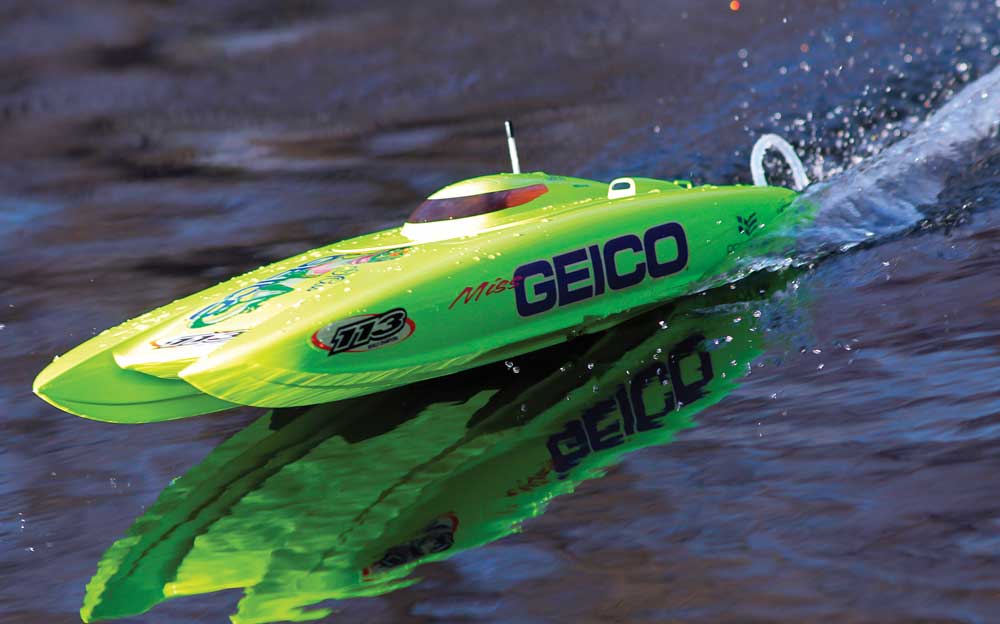
This vibrantly painted cat is the middle child in Pro Boat’s family of Miss GEICO vessels. It’s positioned in between the 29-inch brushless version and the 17-inch brushed version. Catamarans handle a bit different than your typical mono hull, which is often the first style of boat recommended for first-time RC boat pilots. However, the sleek hull and electric yellow color of the Miss GEICO 24 make the boat a target for RC drivers wanting to test their driving skills on the water. Since the motor is brushed, the performance is in a comfortable range for most beginners who have experience with land RC.
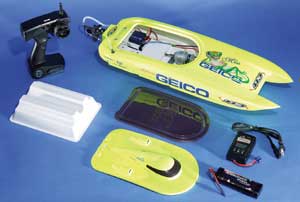
AT A GLANCE
WHO MAKES IT: Pro Boat
WHO IT’S FOR: Novice to Intermediate
HOW MUCH: $209.99
BUILD TYPE: Ready-to-run
BOAT TYPE: Catamaran
THE BOTTOM LINE: A beautiful boat, perfect for small to medium sized ponds. Mild performance out of the box, but it can be upgraded with aftermarket equipment when more speed is desired.
NEEDED TO COMPLETE
• Four “AA” batteries for the transmitter
SPECS
HULL TYPE: Catamaran
HULL MATERIAL: ABS plastic
BEAM: 8.75 inches (222mm)
LENGTH: 25 in (635mm)
MOTOR: Brushed 550-size 15T, water-cooled
ELECTRONICS: Dynamite 50-Amp brushed marine speed control
RADIO SYSTEM: Pro Boat 2.4GHz marine
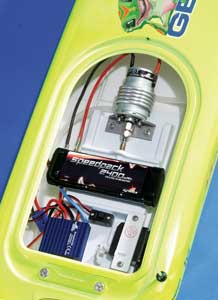
HULL
The catamaran style hull is made from ABS plastic and is the brightest hurt-your-eyes yellow on any boat I have seen. I love it! The sponsons are notched to aid in getting the boat on plane and with turning ability. The hatch is held in place with magnets and a small latch on the rear. Beneath the hatch is another lid, much like many food storage containers. This seals tightly to keep water out. Beneath that you’ll find the ESC, power switch and receiver all held in place with Velcro. This is convenient when you need to perform repairs or maintenance. The front of the hull has foam to prevent the boat from sinking in the event of an accident. The water pick up is directly behind the prop and it exits the hull on the starboard (right) side.
RUNNING HARDWARE
The MG 24 is equipped with a stern drive system, also known as an inboard/outboard. The motor is connected to the prop using a flexshaft and U-joint. The rudder and prop are part of a single unit that is comprised mostly of plastic parts and both turn to provide quick steering. The prop angle can be adjusted to suit water conditions. The hull is not equipped with trim tabs or turn fins, although I think it could benefit from a turn fin.
POWER SYSTEM
Power starts with the Dynamite 50Amp brushed speed control with EC3 battery connector. The forward/reverse controller operates on a single six- to eight-cell NiMH battery. Motor size is limited to 15T. It does not have a LVC (Low Voltage Cut-off) so it is important to keep this in mind should you decide to use a LiPo pack. The compact sleek design is waterproof. A 15T brushed motor is nestled inside a cooling coil that controls motor temps by pushing water through it.
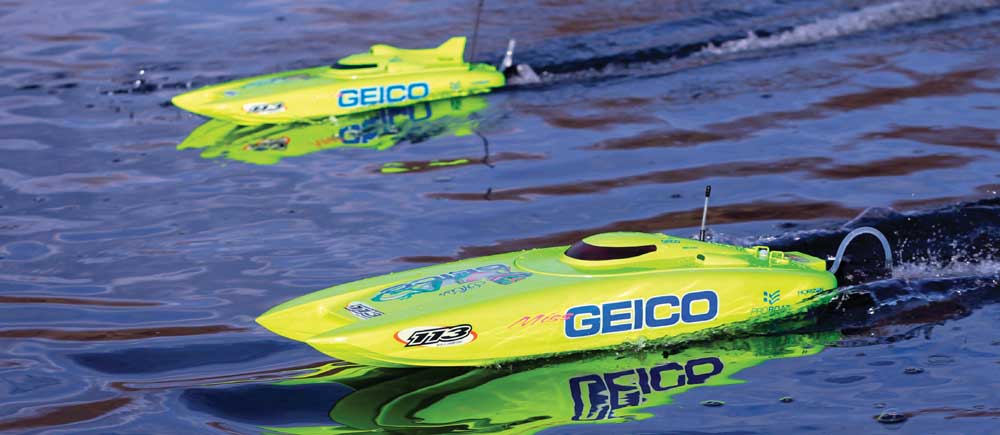
RADIO GEAR
The 2.4GHz Pro Boat radio system features dual rate trims for both the throttle and steering. Standard trim functions and servo reversing complete the short list of features. The system may not seem flashy, but if works very well, providing trouble-free control of the Miss GEICO 24. The 2-channel receiver has the servo and ESC leads sealed into the unit with what looks to be a silicon sealant. This keeps the water out. A Pro Boat PRB0511 servo is used for steering.
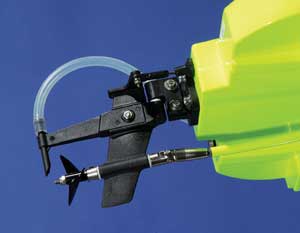
PERFORMANCE
A Dynamite Speedpack 2400mAh NiMH battery and charger are included with the boat. The charger is much quicker than some of the wall chargers included in other’s kits. It is a simple plug and play unit with very easy operation. I topped off the pack and headed to the neighborhood pond, which has recently been completely rebuilt. It’s now free of vegetation both in the water and around the shoreline. I installed the pack, turned on the receiver power and secured the interior lid before mounting the hatch in place. After a quick control check while on the boat stand, I placed the boat in the water and gave it a gentle push away from the shallow shore. I wasted no time squeezing the throttle so I could see how quickly I could cross the pond. The boat had other ideas. The transom dug into the water, which lifted the bow up and then caused the prop to start cavitating. I eased up on the trigger finger until the bow leveled out and the prop was able to bite. I immediately brought the boat back around so I could take a look at the rudder assembly. I loosened the assembly so I could drop the prop and level it to be parallel with the hull. After placing it back on the water I tried easing into the throttle this time with much better results. The bow still lifted slightly, but leveled out quickly. As I increased speed the bow was bobbing up and down as if driving over a wake even though no wake had yet been created in its path. Once I reached full throttle, the hull eventually got up on plane, but it was usually short-lived and the bobbing would resume. It wasn’t a violent movement and didn’t really hinder the fun, but it wasn’t the smooth line I had hoped to see. If you check out the product video on horizonhobby.com you will see what I am describing. After a few wide loops around the perimeter I started tightening the turns. Wide sweeping turns were very smooth. As I turned tighter the boat almost seemed as though it wanted to roll over a couple of times, but a slight release of the throttle straightened it right up. Perhaps a strategically placed turn fin would help. Of course I had to see just how sharp I could get it to turn. A quick full left or right turn flipped the boat around almost on the same path. I tried that only once in each direction, even though it was fun to watch. I didn’t want to chance having to find a way out to the boat should there be a mishap. It was clear to me that the boat wanted and could handle more power. Since I didn’t have a brushless system in my back pocket I opted for a MaxAmps 2S 4300 LiPo pack. The ESC does NOT have a low-voltage cutoff so I would need to exercise extreme caution and pay close attention to run time and any drop in power. If I decide to use LiPo on a regular basis I will install a low voltage warning LED so I know when it is time to bring the boat in. I was only three seconds on the throttle and had already known I wouldn’t be running this on NiMH very often. The hull was up on plane much quicker and without all the bobbing up and down. Speed was the thing to get this boat to settle comfortably on the water. Don’t get me wrong, you can enjoy a day full of RC boating with several standard packs and can get more out of a larger capacity or 7-cell pack. The 2400mAh kit pack gave me between eight and ten minutes of decent running before it slowed too much to be fun. So you would definitely want a minimum of two packs. Three would be best to allow one to cool while one is charging. Before you decide to run LiPo you’ll want to check with Horizon to find out if doing so may void any warranty on the system. I cannot stress enough that you need a low voltage warning system when using LiPo with the stock setup.

PROS
+ Beautifully designed hull in Can’t-Miss yellow.
+ Includes everything except 4 “AA” batteries for the transmitter
+ Dynamite electronics, including a 50amp ESC that will handle 6-8 cell NiMH packs.
+ Easy access hatch with sealed lid underneath keeps water out.
CONS
– Struggles to get on plane with the included 6-cell pack
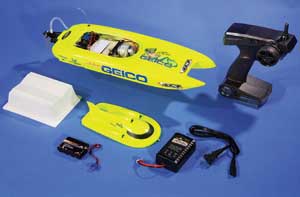
Miss GIECO 17
The smallest sibling in the Miss GEICO lineup With three sizes of this highly visible catamaran you are sure to find one that fits your driving skills or body of water. The MG-17 is a brushed model that is the perfect size for small ponds and even a large swimming pool. A 2.4GHz system controls this one as well. Its features are similar to the 24. The main design difference is in the prop/rudder department. The prop shaft is stationary and the rudder, while still lined up directly behind the prop, has a breakaway feature in case the boat runs ashore. The small shear-pin that keeps the rudder aligned does not fit as snug as it should. I used a small section of decal sheet material on each side of the shear-pin holes to keep it in place. The included 7.2V NiMH Speedpack scoots the boat quite nicely through calm waters. I suggest moving the motor and battery as far forward as possible to help the boat reach plane a little easier. I was getting about eight decent minutes of runtime. For a couple clicks over $100 you can take one of these puppies home and start making wake within an hour of opening the box. That is about all the time needed for the included quick charger to peak the pack. If you can’t decide which size you want, the 17, 24 or the brushless 29, just get one of each.
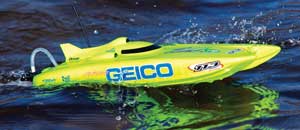
DOCKSIDE DEDUCTIONS
I’ve driven many RC boats in various sizes and styles. The Catamaran is a favorite for the sleek look of the hull and the way they glide once up on plane. The Miss GEICO 24 is a great addition to my boat dock. I wouldn’t be afraid to hand the controller over to just about anyone wanting to try it. I could consider a brushless set up if I decide to upgrade sometime down the road. For about $200 this catamaran can keep you making waves right out of the box and can handle more when you can handle more.
LINKS
Pro Boat proboatmodels.com, 212-352-1913
Words: David Baker
Photos: Walter Sidas
 RC Boat Magazine The World's Leading Radio Control Boating Magazine
RC Boat Magazine The World's Leading Radio Control Boating Magazine
